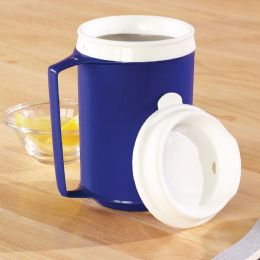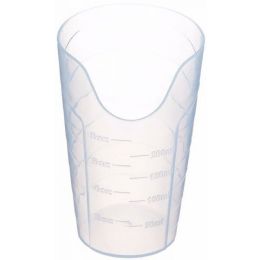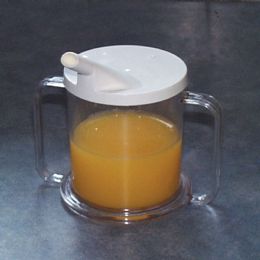



Pediatric cups are available in many styles and sizes, depending on particular needs. They can help an infant learn how to drink from a cup or suck from a straw. Others help those who are handicapped and have difficulty holding onto cups. These cups may have one or two handles on them. Some cups have weighted bottoms to help prevent them from tipping over, while other cups have lids to keep them from spilling their contents. Some are shaped differently to accommodate an individual with special needs, such as a nosey cup, while others are made to help those who have difficulty swallowing.
What is a Sippy Cup?
A sippy cup refers to a cup with a plastic spout and lid, used to help train babies and infants to drink from a cup. It can also help those who have a disability or handicap to more easily hold onto a cup. It can be challenging for babies, infants, or those with a disability to drink from a regular cup. Controlling tipping the cup up in order to drink from it takes fine motor control that babies and those with a handicap may lack. Drinking from a regular cup may lead to sputtering and choking on liquids when too much liquid is taken into the mouth. Also, many babies spill their drinks and may overturn a cup for fun and play to see its contents flow out. This is natural baby behavior that can be somewhat reduced by using a sippy cup.
To minimize spills, the lid on the cup may have a spout that requires some suction from the user in order to release the liquids. Some brands use a rubber or plastic valve which fits into the spout to keep it leakproof. This means that if the cup is turned over, the liquid will not leak from the cup if it fits snugly. The lid of a cup that is designed for young babies (5 to 8 months old) may also mimic a breast nipple or bottle in shape. Some feel this type of design helps a baby more easily transition from bottle or breast feeding.
Once a baby has gotten used to using a cup with a nipple type spout, a more advanced or regular spout may be used. Some parents do not use the nipple spout on a sippy cup, but go straight to a small sippy cup with a semi-prismatic shaped spout. Another feature which may be included in a sippy cup is a slightly weighted and rounded bottom. Some manufacturers make a tumble style cup, or it may be more generically called a tippy cup. If the cup is knocked over, it tips and springs back up.
As a child gets a little older, a parent may still want to minimize large spills by using a simple plastic cup with a lid and a spout. This type does not require suction to drink, but still releases the liquid more slowly than a regular cup would. This enables small spills to be caught more quickly and easily.
When a sippy cup should be introduced to a child depends on the abilities of that child. Some parents start babies on sippy cups at about four or five months of age, while others wait until a baby is eight to ten months old before trying a sippy cup. The earliest liquids should simply be water, formula, or breast milk, especially if the baby is under a year old and still taking formula or nursing. When babies get mobile, they should not be able to move around with a sippy cup or a bottle. Spills can happen, and babies can accidentally fall on the cup and cut their mouth. Use care when washing the lids, particularly when using a dishwasher. They can melt if the water and heat is too hot. Try to keep the lids on the top rack of a dishwasher, or wedge them between cups to prevent them from falling into the lower rack and onto the heating element.
Rehabmart is pleased to carry a vast selection of assistive pediatric cups from superior quality vendors, including Bionix Medical Technologies, Sammons Preston, Maddak, Independence Medical, and North Coast.
Hulet Smith, OT
Rehabmart Co-Founder & CEO
lb